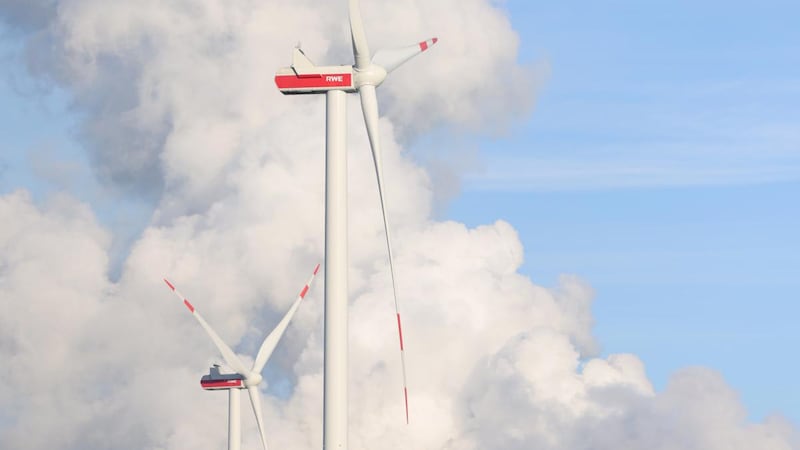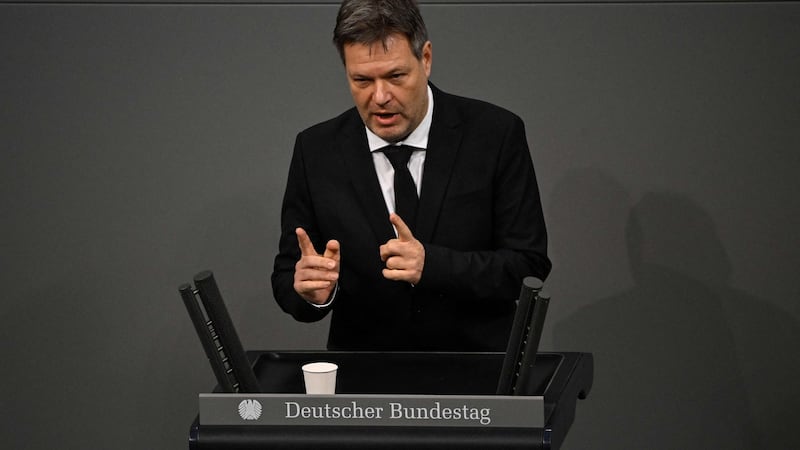Robert Habeck looked – and sounded – like a trainee undertaker during his first Bundestag address as Germany’s new minister for economics and climate protection.
In an ill-fitting black suit, white shirt and black tie, Mr Habeck spoke without notes and delivered a brief, calm eulogy on the era of fossil fuel prosperity.
Europe was experiencing the final death throes – an inflation bubble driven by rising energy prices – thanks to a “hunger for fossil energy”. More than ever, he said, it was time for Germany and Europe to embrace renewable energy to break its addiction to gas, oil and coal.

“We can describe this as a great threat, but in truth it is a chance to grow, literally: to grow prosperity and wealth and still make ourselves more independent from raw material imports...and reduce CO2 levels,” said Mr Habeck, a 52-year-old Green Party co-leader, part-time philosopher and author.
Europe’s largest economy is balanced on the brink, he said, with time running out to reconcile Germany’s growing conflict between its energy needs and climate goals.
“In my ministry we have had no time to acclimatise ourselves,” he said. “Just like our country and society, we have to get started immediately.”
As Germany’s new coalition government of Social Democrats (SPD), Greens and liberal Free Democrats (FDP) get down to work, Germany is about to make the most daring leap in modern industrial history – or is on a ruinous road to nowhere.
By 2030 the country has committed to reducing its CO2 emissions by 65 per cent compared to 1990 levels. By the start of the next decade, it also wants to have doubled its renewable energy sector to provide 80 per cent of Germany’s energy needs.
By the end of this year, meanwhile, Germany will have ended its nuclear era, in line with Angela Merkel’s 2011 post-Fukushima U-turn.
While CO2-free nuclear power is enjoying a renaissance in France and elsewhere, Germany’s staggered shutdown will be completed this year when three remaining nuclear power plants go off the grid.
Renewables shift
The beginning of the end of nuclear power in Germany predates the Merkel era, though, to the last time the Greens were in power.
In 2001 they reshaped Germany’s energy future by agreeing with their SPD coalition partners to shift from nuclear to renewable energy. Their proposals for an “Energiewende” or energy transition, coming with generous public subsidies and guaranteed grid feed-in fees, created huge demand for builders of turbines and solar panels.
The latter has had a turbulent time in the years since, in particular given ruthless competition from China. But the results of the first Green/SDP renewable push remain palpable today: renewables make up 41 per cent of Germany’s total energy mix in 2021, more than double the EU average.

But the future is less certain. In particular, how can Germany fill the 12 percentage point energy gap left by the final nuclear shutdown without starving its industrial machine of energy – and without punching a hole in its climate goals?
Germany plans to take one step back to go two steps forward. To bridge the gap until 2030, Germany will have to increase its reliance on gas and coal, which account for 15 and 28 per cent of the current energy mix respectively.
Strip-mining of lignite – one of the world’s dirtiest fuels – continues in Germany, west and east, for coal-burning plants. Meanwhile, a German energy agency will decide later this month on an operating licence for the controversial Nordstream project, a 1,200km pipeline bringing Russian gas directly to Germany, to the fury of its eastern neighbours – and Washington.
Geopolitical headaches aside, Mr Habeck has made clear his distaste for the pipeline but he is pragmatic enough to embrace the realpolitik.
Carbon emissions
New data shows that German CO2 production jumped 4.5 per cent last year and Mr Habeck has acknowledged that Germany will miss its own carbon-cutting goals for this year and next.
Though these are painful concessions for a Green minister, energy experts are hopeful that the new Berlin coalition can revive the spirit of the original Energiewende plan, using a mix of subsidy carrots and legislative sticks.
Simon Müller, of the Agora Energiewende think tank, said: “2022 has to be the year of climate measures, when the federal government takes seriously its commitment to the 1.5 degree goal.
“Only a fast-working, far-reaching action plan can prevent the gap widening between climate goals and climate measures.”
Unlike 2001, Germany’s new government in 2022 has a new, untested element: the liberal, free market FDP.While the original SPD-Green Energiewende plan was triggered with public money and subsidies, FDP leader Christian Lindner – the new federal finance minister – insists this round of green transformation must be lead by private sector investment.
That was a focus of Mr Lindner’s talks last week with his Irish counterpart Paschal Donohoe, visiting Berlin as Eurogroup president. Mr Donohoe said Europe was watching with interest for German leadership on its green economic shift, “where the contribution of the private sector, not just the role of public capital, is crucial to allow us deliver this ambition”.
Green and FDP politicians – usually seen as far apart on the political spectrum – realised during last autumn’s coalition talks that they had more in common than they thought. Their epiphany – use public money to spark a green German engineering revolution – is reflected in their programme for government’s assertion to “create incentives for private individuals and space for entrepreneurial risk-taking”.
At his party’s annual Epiphany Day gathering, the FDP’s Mr Lindner went even further, vowing to drag climate protection into the mainstream, transforming it form “niche topic to a prosperity and growth topic”.
Climate-friendly
In a friendly dig at his more leftist coalition allies, the FDP leader promised to deliver a climate-friendly economic transformation that favours “technological and financial ambition” rather than “petty prohibition”.
With growing pressure to succeed, Mr Lindner hopes German engineering prowess can be refocused on green transformation products and solutions, creating 21st century equivalents of industrial giants Siemens and Bosch.
While the FDP insists this transformation will be bankrolled by private capital, and Mr Lindner promises to return post-pandemic Germany to balanced budgets, the finance minister has made an early gesture of goodwill: reassigning some €60 billion of unspent Covid-19 emergency funding to the country’s main climate investment fund.
With that move facing political and legal challenges, FDP and Greens agree that Germany’s ambitious leap towards a decarbonised economy is as much about mentality as money.
The challenge for Mr Habeck and his cabinet colleagues is to resolve the tension among German citizens between their Nimby (not in my back yard) and Tina (there is no alternative) selves.
By closing the door to nuclear, Germany has no energy alternatives to renewable energy. Yet in a 2021 survey, overwhelming public support for renewable energy (80 per cent) halved to 43 per cent when it came to respondents accepting wind turbines nearby.
Germany’s new coalition has vowed to grab the nettle with far-reaching planning law reform to cut the six years on average it takes to plan and build a new wind energy park in Germany.
Redefining renewable energy as a national strategic priority will expedite matters, allowing solar and wind farms override conservation laws and resident concerns.
Plans are under way, too, to free up more land for wind and solar farms by reducing minimum distances to residential areas. In Bavaria, for instance, a 200m high turbine can be erected no closer than 2km from the nearest home.
The clock is ticking: Germany wants to achieve 200 gigawatts of renewable energy output by 2030, which means adding a massive 20 gigawatts of energy production annually. Meeting this ambitious target, Mr Habeck has warned, “won’t be possible without making demands on people” – and their comfort zones.
“I hope that, as a society, we are able to get over ourselves,” he said. “Otherwise we will get nowhere.”











